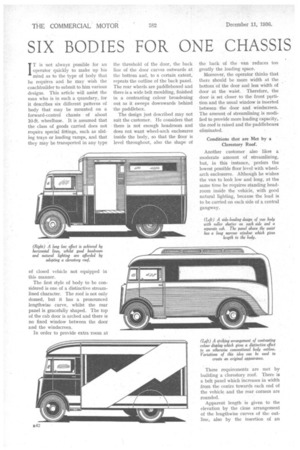SIX BODIES FOR ONE CHASSIS
Page 60

Page 61

If you've noticed an error in this article please click here to report it so we can fix it.
IT is not always possible for an operator quickly to make up his mind as to the type of body that he requires and he may wish the coachbuilder to submit to him various designs. This article will assist the man who is in such a quandary, for it describes six different patterns of body that may be mounted on a forward-control chassis of about 10-ft. wheelbase. It is assumed that the class of goods carried does not require special fittings, such as sliding trays or loading ramps, and that they may be transported in any type
of closed vehicle not equipped in this manner.
The first style of body to be considered is one of a distinctive streamlined character. The roof is not only domed, but it has a pronounced lengthwise curve, whilst the rear panel is gracefully shaped. The top of the cab door is arched and there is no fixed window between the door and the windscreen.
In order to provide extra -room at the threshold of the door, the back line of the door curves outwards at the bottom and, to a certain extent, repeats the outline of the back panel. The rear wheels are paddleboxed and there is a wide belt moulding, finished in a contrasting colour broadening out as it sweeps downwards behind the paddlebox.
The design just described may not suit the customer. He considers that there is not enough headroom and does not want wheel-arch enclosures inside the body, so that the floor is level throughout, also the shape of the back of the van reduces too greatly the loading space.
Moreover, the operator thinks that there should be more width at the bottom of the door and less width of door at the waist. Therefore, the door is set closer to the front partition and the usual window is inserted between the door and windscreen. The amount of streamlining is modified to provide more loading capacity, the roof is raised and the paddleboxes eliminated.
Conditions that are Met by a Clerestory Roof.
Another customer also likes a moderate amount of streamlining, but, in this instance, prefers the lowest possible floor level with wheelarch enclosures. Although he wishes the van to look low and long, at the same time he requires standing headroom inside the vehicle, with good natural lighting, because the load is to be carried on each side of a central gangway.
These requirements are met by building a clerestory roof. There is a belt panel which increases in width from the centre towards each end of the vehicle and the rear corners are rounded.
Apparent length is given to the elevation by the close arrangement of the lengthwise curves of the outline, also by the insertion of an elongated contrasting panel of colour above the waist.
Occasionally the customer is not quite sure what he wants, but he requires something out of the ordinary. At the same time, as the load is usually packed in fairly large cases, he considers that streamlining will be out of the question. In this instance, the outline of the body may be conventional and character is given to the general appearance by some striking display of colour arrangement and contrast.
A Simple but Effective Colour Scheme.
The loading portion has a wide diagonal band, which at once arrests attention, because the sides of this band of colour are notched. Along the roof and bottom of the body are wide and narrow bands of colour, which are joined by vertical lines of contrasting colour at the front and rear of the loading portion. As the sides of this " frame " are of different design from the top and bottom, and are interrupted by the dominating diagonal band, an attractive background for writing display is provided. The cab is painted so that the upper and lower bands of colour are extended to the front of the vehicle. The paddleboxing of the rear wheels is an advantage, because a complete rectangle is provided for a balanced and striking display of colour.
The number of side-loading vans is continually on the increase, so that it is quite likely that this feature will often be mentioned when a new body is being discussed. The side opening may be incorporated in any of the types of body already described, or a van with a separate cab, such as is provided by the chassis manufacturer, may be specified. The loading portion may have rounded corners both back and front, and with a flat or shaped back panel. The belt panel may be of the conventional or curved patterns.
The loading portion will be about 10 ft. long and, with 5 ft. 6 ins. headroom inside and panels extended below the chassis, the overall height of the body will be about 7 ft. In order to counteract any effect of topheaviness the horizontal lines of the body should be emphasized wherever possible, by the addition, for instance, of a long, narrow panel between the roof and waist.
Another solution of the bodywork problem is quite a simple one and consists of building a plain platform which accommodates a lift van or two or three smaller containers. The removable box body may be loaded or unloaded independent of the platform lorry, which may be utilized to transport another lift van, or the load may be piled directly on the platform.




































































































